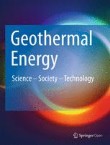Associated Societies
Characterizing the physical properties of rocks from the Paleozoic to Permo-Triassic transition in the Upper Rhine Graben
Geothermal energy exploitation in the Upper Rhine Graben currently targets high-temperature anomalies in the crystalline Paleozoic basement at depths up to 5 km. However, at certain locations (e.g. Rittershoff...
